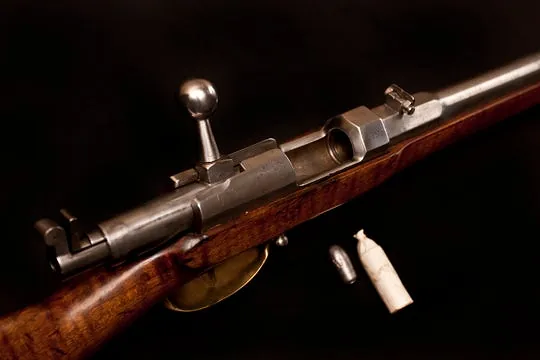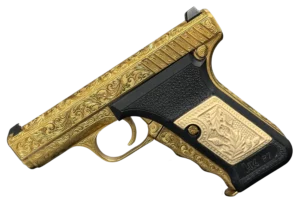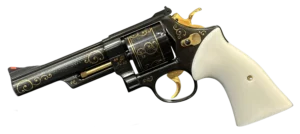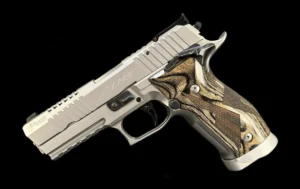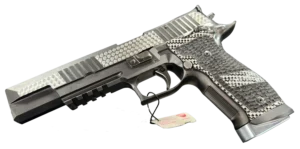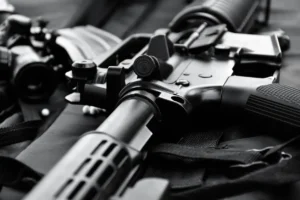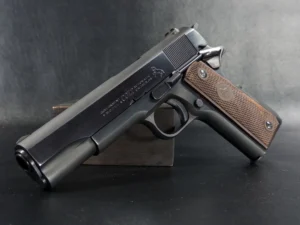3 Key Takeaways:
- The guns that flopped often paved the way for the ones that didn’t: The Volcanic Repeater didn’t win any wars, and the Chauchat jammed like a nightmare — but both were stepping stones. Innovation’s messy like that. You fail, you learn, you build the next thing better.
- Some of the most radical ideas came way too early: An 18th-century air rifle with a 20-round mag? Yeah, that happened. The Girardoni was so ahead of its time, people didn’t know what to do with it — but its DNA still lives on in modern tech.
- Forgotten doesn’t mean unimportant: These guns didn’t become household names, but they left fingerprints all over history. Their designs, ideas, and even their flaws helped shape how we fight, build, and think about firearms today.
Let’s be honest: when people talk about history-changing guns, it’s always the usual suspects — the AK-47, the Colt 1911, maybe the M1 Garand if they’re feeling nostalgic. But what about the ones history kinda forgot? The oddballs. The brilliant flops. The guns that changed everything… and then disappeared into footnotes.
This is about those.
These are the strange, ahead-of-their-time, sometimes misunderstood weapons that nudged the course of history — not with a bang exactly, but with a quiet click, a hiss of compressed air, or a bolt sliding forward just a little faster than before.
First, a Bit of Context (Because It Matters)
If we’re gonna talk about these forgotten firearms, we’ve gotta rewind. History doesn’t happen in a vacuum — it’s messy, loud, political, and expensive. Wars push tech forward. So does ego. So does the terrifying realization that your neighbor just built a better rifle than you and now you’re in trouble.
Gunpowder showing up in the West? That was the starting gun. From that moment on, it was a race — not just to build guns, but to outbuild everyone else’s guns. As metallurgy got better and folks figured out things like rifling and breech-loading, it wasn’t just about who had more muskets. It was about who had the better ones.
And yeah, economics played a part. A genius design that’s too expensive to mass-produce? That’s just a museum piece waiting to happen. Politics, war, money — these are the forces that shaped (and sometimes buried) these firearms.
Now that we’ve set the stage — let’s meet the misfits who changed the rules.
1. The Volcanic Repeater: The Gun That Couldn’t, But Sorta Did
You’ve probably never heard of the Volcanic Repeater. Most people haven’t. But if you’ve ever handled a Winchester, you’ve touched its grandchild.
Back in the 1850s, the Volcanic Repeater was doing something nobody else was pulling off — lever-action firing with a self-contained cartridge—wild stuff for the time.
It wasn’t perfect, though. The ammo was weak. The gun was underpowered. And it jammed more than it should’ve. But even with all that, it cracked open the door to what would become the legendary American lever-action rifle.
You can draw a straight line from the Volcanic to the Henry to the Winchester 1866 — a rifle that worked and made history. But that first step? That awkward, underpowered, kinda weird first step? That was the Volcanic.
So no, it didn’t win any wars. But it redefined what was possible.
2. The Dreyse Needle Gun: The Quiet Killer of Muzzleloaders
Now here’s a rifle that did make waves — the Dreyse Needle Gun. Prussian army, 1841. Bolt-action. Breech-loaded. Way ahead of its time.
Before this thing, you had to stand up, pour powder down the barrel, stuff in a bullet, and then try not to get shot while ramming it all home. The Needle Gun changed that — you stayed down, opened the breech, shoved in a cartridge, closed the bolt, and fired. Fast. Safe(ish). Deadly.
This mattered — a lot — in the Austro-Prussian War. The Prussians were mowing down Austrian troops before they could even finish reloading. It wasn’t just about the tech — it was how that tech changed the way armies moved and fought.
The name “Needle Gun” comes from the long, sharp firing pin that pierces through the cartridge to ignite the powder. Kinda delicate, fussy, but groundbreaking nonetheless.
And bolt-action rifles? Yeah, they pretty much became the standard after this. Every major army took notes.
3. The Girardoni Air Rifle: Wait, an 18th-Century Assault Rifle?
This one is straight-up bonkers.
The Girardoni Air Rifle, an Austrian invention born in the late 1700s, ran on compressed air. No gunpowder. No smoke. No bang. Just a quiet hiss and a lead ball zipping silently through the air. Sound like sci-fi? It gets weirder.
It had a 20-round magazine. It could be reloaded and fired rapidly. And it didn’t need cleaning every five minutes. Think about that — in an age when muskets were single-shot dirt cannons, this thing was a semi-auto ninja.
The Austrians issued it to troops. Lewis and Clark brought one on their expedition across the U.S. — not just for hunting, but to straight-up dazzle Native American tribes with its ghost-like firing.
Why didn’t it take over the world? Two reasons: it was hard to make, and the air reservoirs were fragile. But the tech? Decades ahead of its time. It laid the groundwork for every air-powered weapon that came after.
4. The Chauchat: A Janky Gun That Meant Well
Okay, let’s talk about the Chauchat — arguably one of the most ridiculed guns in history. And yeah… it earned some of that ridicule. But also? It was brilliant.
This was World War I. Trench warfare. Mud, rain, misery. The French wanted a light machine gun — something one guy could carry and fire on the move. Enter the Chauchat.
It was lightweight(ish), had a full-auto mode, and looked like the future. The problem was, its magazine had these big open slots that let in dirt, mud, sand — you name it. In a pristine lab? It worked. In Flanders? Not so much.
Still, it was the first genuine attempt at a portable machine gun. And that concept — mobile, individual firepower — became the backbone of infantry tactics in the future.
Without the Chauchat, we might not have gotten the Browning Automatic Rifle. So yeah, it sucked in a lot of ways. But it walked so others could run.
5. The Liberator: One Shot, One Hope
Now for something completely different — the Liberator pistol. This thing was never meant to be great. It was intended to be disposable. One shot. That’s it.
Made during World War II, the Liberator was stamped out by the million. Literally. Over a million units, made from cheap metal and a few parts, with the hope that they would end up in the right hands.
The idea was simple: drop them behind enemy lines for resistance fighters. They’d use the Liberator to take out a guard, grab his weapon, and upgrade. The gun was a stepping stone, not a final destination.
It was clunky, slow to reload, and useless after the first shot. But symbolically? It was everything. A tiny, tangible middle finger to tyranny.
It didn’t see a ton of action, weirdly — logistics and fear of German retaliation kept distribution limited. But the concept stuck. And in the age of asymmetric warfare, that kind of simple, cheap, morale-boosting weapon still matters.
6. The Nambu Type A: Japan’s Semi-Auto Growing Pains
Let’s wrap with something a little more obscure — the Nambu Type A, sometimes called the “Grandpa Nambu.” This was Japan’s first crack at a semi-automatic pistol, and man, was it… ambitious.
Designed in the early 20th century by Kijiro Nambu (Japan’s own John Browning, kind of), the Type A looked futuristic and had some cool ideas — like an internal striker and a unique locking system.
But it was also clunky. Fragile. And expensive to build. Only a few hundred were made.
Still, it laid the groundwork for the more well-known Nambu Type 14 and Type 94 — the pistols Japan used in World War II. And even if it wasn’t a roaring success, it was the first step in Japan’s push toward self-reliant firearms design. That matters.
Also, it just looks cool. Aesthetically, it’s got that steampunk-samurai energy that makes collectors drool.
So, Why Do These Guns Matter?
Because winners don’t just write history — it’s written by weirdos, underdogs, and misfires. The Volcanic Repeater didn’t win a war, but it helped invent the American rifle. The Chauchat jammed like crazy, but it reimagined battlefield firepower. The Girardoni? It was an 18th-century sneak peek at modern air rifles.
Each one of these forgotten firearms tells a story — not just of innovation, but of what happens when someone dares to build something different. And sometimes, that bold move fails. Sometimes it flops so hard it disappears into obscurity.
But that’s the thing about innovation: it stacks. Every oddball gun paved the way for something better. You don’t get the M4 or Glock or AK without a graveyard full of brilliant, broken prototypes.
And let’s not kid ourselves — rediscovering these old weapons is half the fun. They’re the secret chapters in the book of firearms history. The stories that make you lean in and say, “Wait, they built what?”
Final Thoughts (But Not a Bow)
If you’re a collector, a history nerd, or just someone who appreciates beautiful failures, these are the guns worth knowing. Not because they were perfect. But because they tried something bold.
They’re messy. They’re flawed. They’re forgotten.
And they changed the world anyway.
Frequently Asked Questions
It’s not about being erased from history — it’s about being overlooked. These are guns that played important roles but didn’t get the spotlight. They were ahead of their time, too flawed to last, or just plain weird… and history moved on without them.
Because even the failures moved things forward, think of them like beta versions of the guns we know today — full of lessons, breakthroughs, and mistakes that shaped future designs. You don’t get the Winchester without the Volcanic. You don’t get the BAR without the Chauchat.
Yep. The Dreyse Needle Gun helped the Prussians win wars. The Chauchat — for all its faults — saw serious action in World War I. And the Liberator? It was built to be used by resistance fighters behind enemy lines. These weren’t just concepts; they were out there, being fired in the mud and chaos.
Tough call, but probably the Girardoni Air Rifle. A repeating, silent, air-powered rifle in the 1700s? That’s wild. People didn’t even know what to do with it back then — but today, its design feels surprisingly modern.


